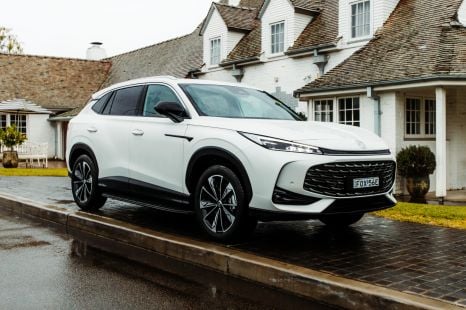

James Wong
3 Days Ago
The Genesis GV80 presents a compelling alternative to established German marques, with Bentley-aping design and a features list as long as your arm.



Marketplace Editor
New from
$90,476
excl. on-roads

Marketplace Editor
New from
$90,476
excl. on-roads


Marketplace Editor
New from
$90,476
excl. on-roads

Marketplace Editor
New from
$90,476
excl. on-roads
Quickly see how this car stacks up against its competition. Select any benchmark to see more details.
Take advantage of Australia's BIGGEST new car website to find a great deal on a Genesis GV80.
I love anything green. So, you can imagine my excitement when I picked up the Genesis GV80 in metallic with cream/brown interior. #Drool
The Korean luxury upstart has its work cut out for it. Trying to sway Australian buyers from established German brands has proved a challenge for even Volvo and Lexus over years and years of trying. How will Hyundai’s premium arm fare?
Well, while it may not have the sales numbers or dealer network to really compete just yet, if you’re an early customer you get exclusivity, and you’ll feel like a celebrity because, well, everyone just stops and stares.
I can’t tell you how many times I passed people in Melbourne’s CBD and saw necks crack to figure out what I was driving, I even got stopped in multiple carparks by people asking me questions about the car. I’ve never driven a car that’s sparked such intrigue.
The GV80 looks part Bentley Bentayga, part Audi, part Cadillac. It’s a mix of Euro and American design influence that certainly cuts a line in traffic. Personally, I think it’s stunning.
With three engine variants, one main trim level and one option pack, the Genesis GV80 range is simple, highly-specified, and aiming square at the likes of the Audi Q7, BMW X5 and Mercedes-Benz GLE. Beyond the Big Three, there’s the likes of the Lexus RX, Volkswagen Touareg, and Volvo XC90, too.

Priced from just over $90,000 for the entry-level four-cylinder petrol variant we have on test here, this isn’t exactly cheap when many will view this car simply as a tarted-up Hyundai.
That couldn’t be further from the truth, but at this end of the market, perception is everything.
So, can this new Korean SUV cut it with Europe’s luxury elite? Or will it turn out to be another failed attempt in Australia a-la Infiniti? Let’s find out.

Here we have the most affordable variant in the GV80 range – the 2.5T RWD – which is priced from $90,600 plus on-road costs.
Our test car’s $10,000 Luxury Package bumps the as-tested price to $100,600 before on-roads, meaning you can have a decked-out GV80 for the same price as entry versions of rival models like the Audi Q7 and BMW X5 – both of which start at $100,000 before fees and taxes.
Should you want the added traction of all-wheel drive and a third row of seats, the 2.5T AWD is $95,600 list. The sole diesel is the 3.0D AWD ($103,600) and the range-topper is the 3.5T AWD twin-turbo V6 ($108,600).
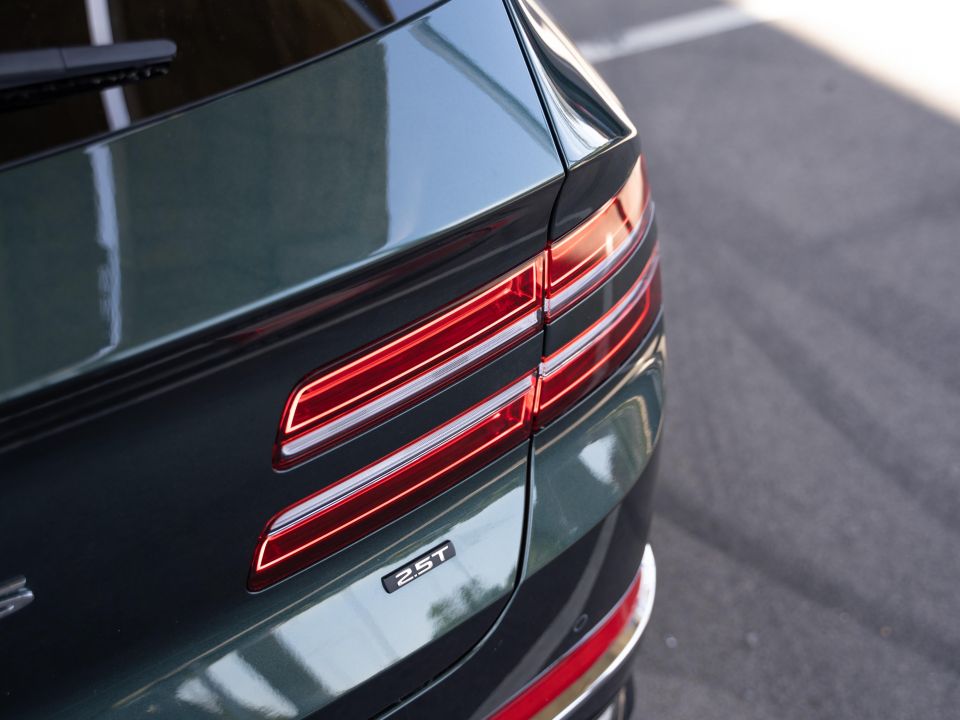
All engine variants are largely identically specified (with some small differences), and all are available with the Luxury Pack as we have on test – full details in the next section.
So, the base model’s circa-$90,000 starting price puts it within range of a number of rivals, including the Volkswagen Touareg 210TDI Elegance ($99,490), Lexus RX300 Sports Luxury ($94,386), Audi Q7 45 TDI quattro ($101,900), BMW X5 xDrive25d ($102,900), and the Mercedes-Benz GLE300d ($105,089).
It’s worth noting while the Q7 and Touareg feature six-cylinder diesels as standard, the RX300 Sports Luxury is the top trim level with a four-cylinder turbo petrol – much like the Genesis we have on test – while the GLE and X5 fit four-pot turbo diesels in base trim.
The stunningly gorgeous Cardiff Green paint is a no-cost option, with the only finishes incurring a charge being the handful of matte paints that ask for an extra $2000. Not bad.
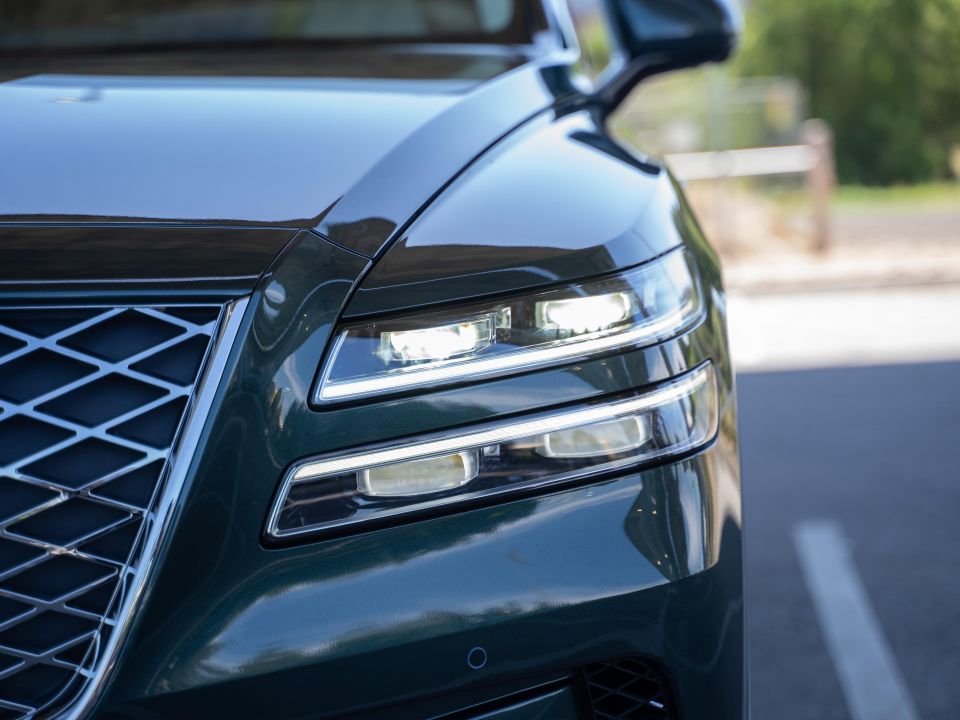
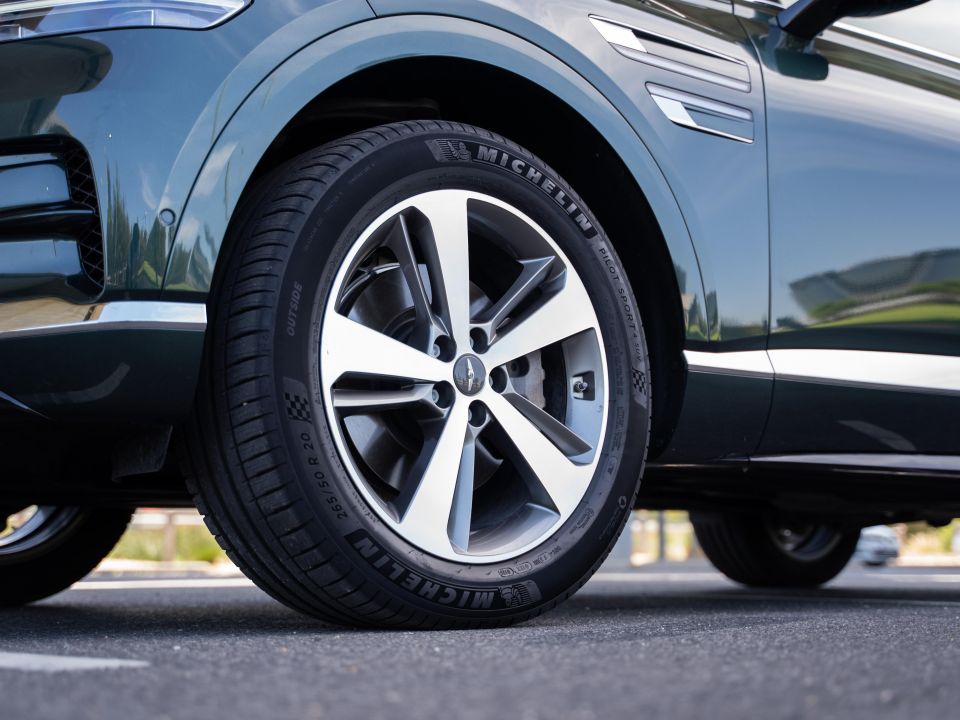
Quite a lot. Standard equipment on all models includes:


The car we have on test is also fitted with the $10,000 Luxury Package, which adds:
The only stuff available in the catalogue the 2.5T misses out on compared to the six-cylinder models are the larger 22-inch wheels, adaptive dampers, and a rear limited-slip differential.
Also, being the rear-wheel drive model, the vehicle we have on test misses out on seven seats – you need one of the all-wheel drive models for those.

Crash testers ANCAP and Euro NCAP are yet to officially test the new GV80, but it’s filled to the brim with safety kit.
All models come standard with the Genesis Active Safety Control suite, which includes autonomous emergency braking with pedestrian and cyclist detection, forward collision warning, junction and cross-traffic AEB, and evasive steering assist.
Other safety features include:
There are also 10 airbags, including a front-centre airbag between the front seats. Models equipped with the Luxury Package, like our test vehicle, add AEB in reverse.
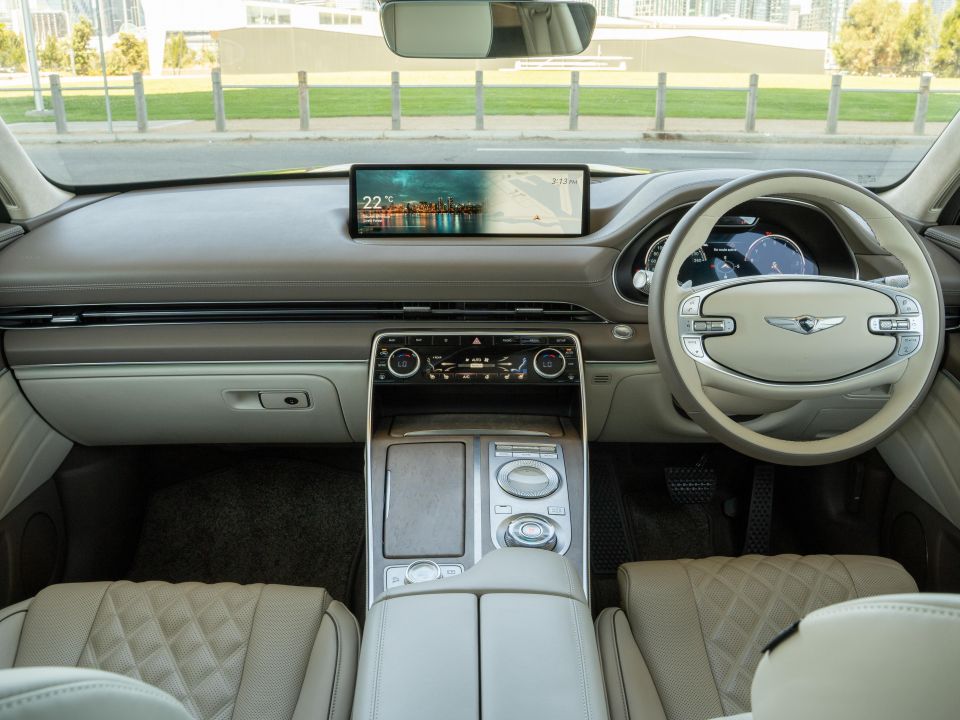
While design is entirely subjective and it’s no secret the GV80 polarises inside and out, you can’t deny that it has wow factor.
Hop in and you’re greeted by the odd throwback two-spoke steering wheel, lashings of leather, wood and metal accents, contrasting colours and trims, as well as gorgeous, high-resolution displays.
Now, the Luxury Pack fitted to our test vehicle really helps with this feeling of luxury – you’ll find it’s much more exciting than the interior of the non-luxury GV80 3.0D AWD my colleague Mike Costello recently drove – but just the overall design and layout is really eye-grabbing, beautifully made, and unlike anything in the class.
Don’t get in thinking this is a tarted-up Santa Fe, either. The cabin is totally bespoke and even the switchgear is all Genesis, not Hyundai.
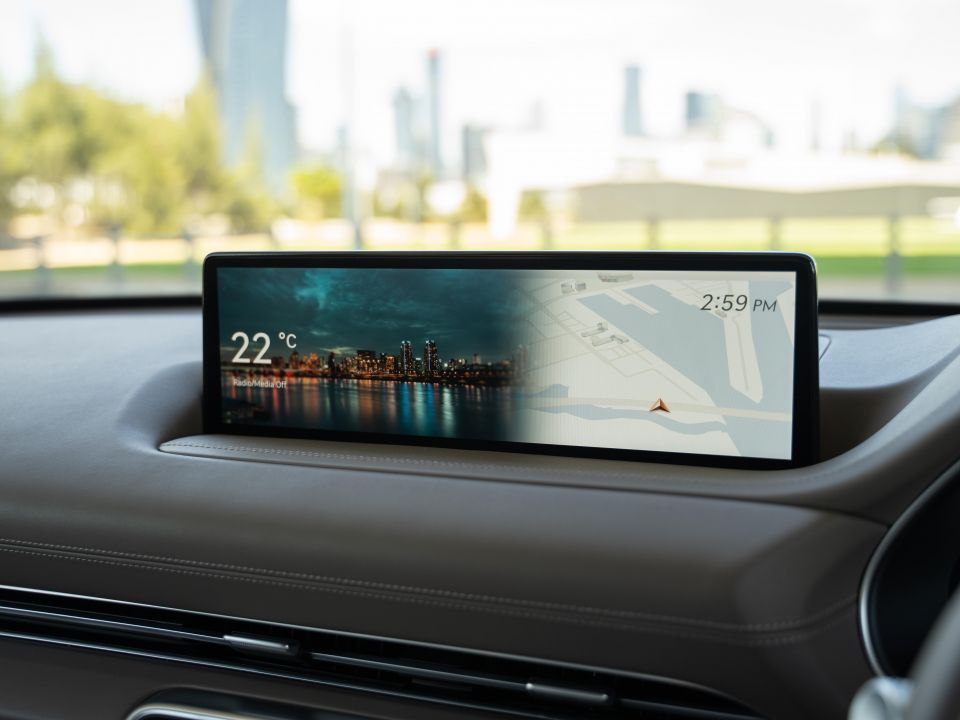

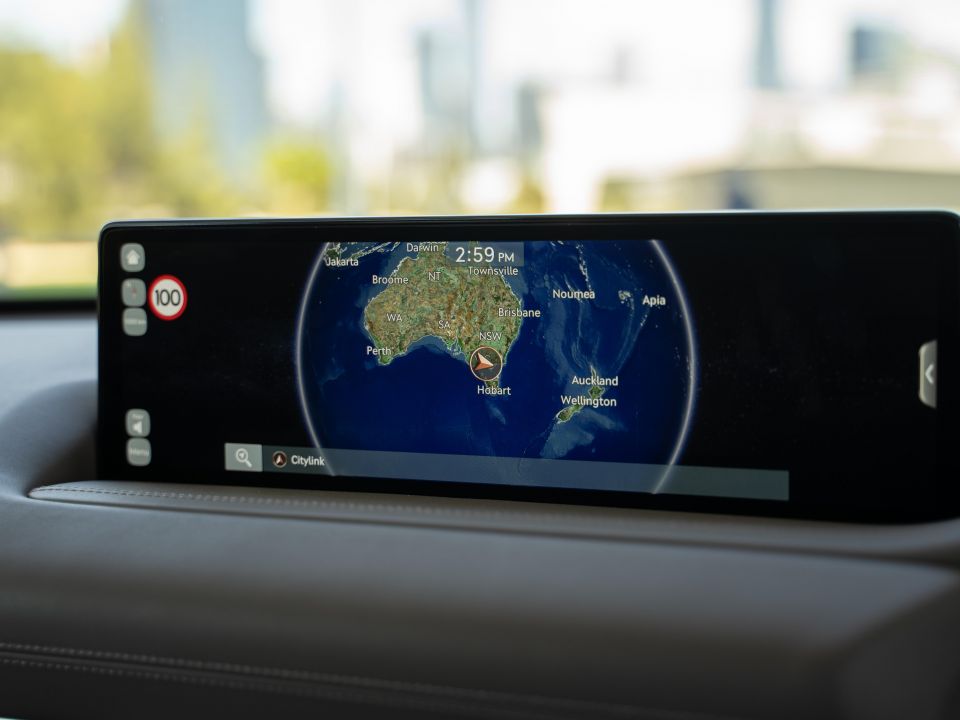



You may notice family ties in some of the fonts and symbols used for the switchgear and displays, but even the 14.5-inch widescreen infotainment system has its own interface unique to the luxury upstart.
On the topic of infotainment, the resolution, graphics and response times are all top-notch. It may not be familiar for those stepping up from Hyundai/Kia products nor converts from European brands, but it’s certainly up to the task and also features wired Apple CarPlay and Android Auto if you get sick of the native system or prefer to use your phone apps.
The inbuilt navigation system also has an augmented reality function that will use the forward-facing camera to project directions and prompts onto the road ahead of you via the screen. It’s quite neat and is really only matched by Mercedes-Benz models optioned with a similar function.
Further, the 21-speaker Lexicon surround sound system is nothing short of banging. Sound is crisp, clear, and you can really turn up deep, thumping bass.
There’s even that Hyundai Group ‘Sounds of Nature’ program that to me is nothing more than a left-field gimmick, but my 11-year old cousin thought it was neat and suggested I try the rainy day soundtrack with the air-con turned to freezing with a cup of hot chocolate. Kids, what can I say.


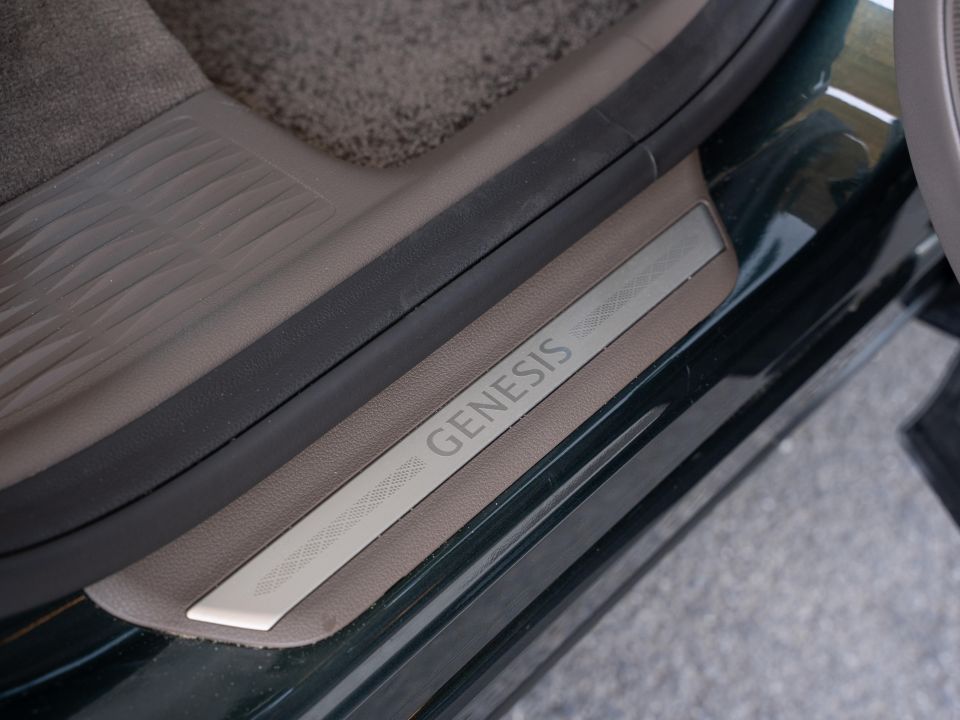

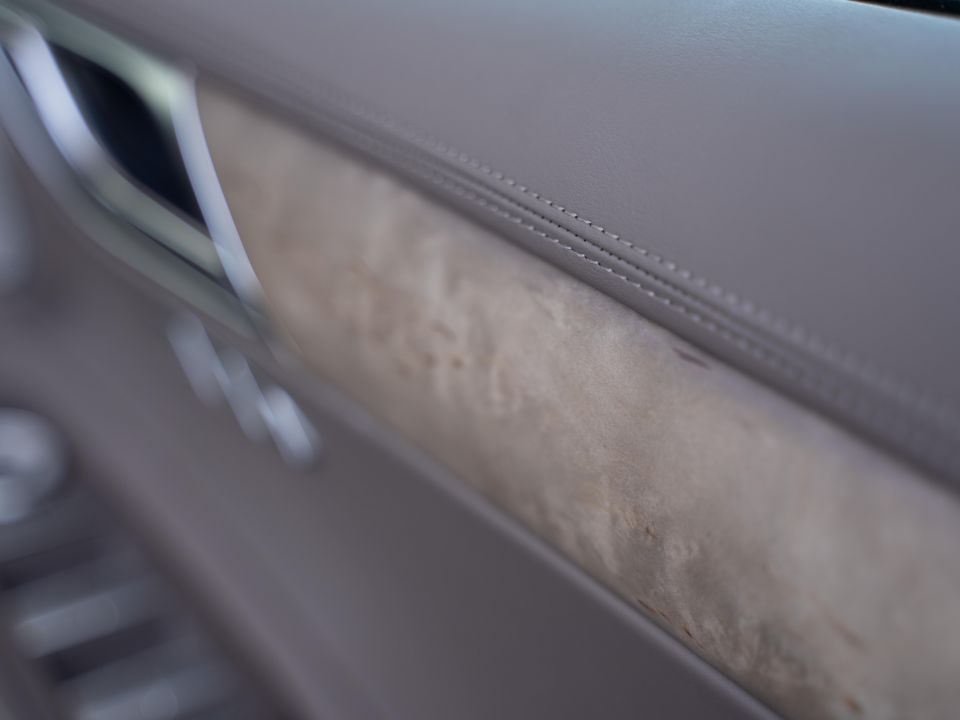
Everything you touch is padded with leather or leatherette surfaces, and the wood trim is real. It’s quite a throwback to what your traditional idea of a high-end vehicle is, right down to the Bentley-esque diamond leather quilting.
I personally love the colour scheme of our test car – #makegreengreatagain #greenovertan – and there’s four different interior colourways and two different wood trims to choose from. It’s a shame you can’t get some of the additional options available in Korea, but it’s as much choice as anyone else at this end of the market without having to go through a bespoke program.
Both front seats are comfortable and feature electric adjustment, but only the driver gets memory and massaging functions. There’s so much range of adjustment that getting comfortable is no hard task.
You certainly feel like you’re in something special, and it’s a very nice, comfortable place to sit. That said, some of the interior elements don’t come without their quirks.




The circular control used for the infotainment (supplemented by touchscreen functionality) can be a little fiddly to use on the move. It’s got quite a heavy motion and clicks as you rotate it to signify inputs, but it’s very easy to overshoot selections as it’s a dial rather than a knob.
The touch-capacitive climate controls have similar quirks. While the physical rotary dials for the temperatures look and feel nice to use, there’s a screen in between for functions like air circulation and seat ventilation which can be a little fiddly and at times hard to read because the virtual buttons are quite small.
Ahead of the driver you have an interesting virtual cluster that has 3D modes, and a pair of cameras that monitor your eyes as part of the driver attention monitoring system.
The 3D effect might be a gimmick to some, but the dials themselves are quite attractive, give you decent customisation (three different themes) as well as plenty of real estate for driver information – though no mapping like you can get in other products.
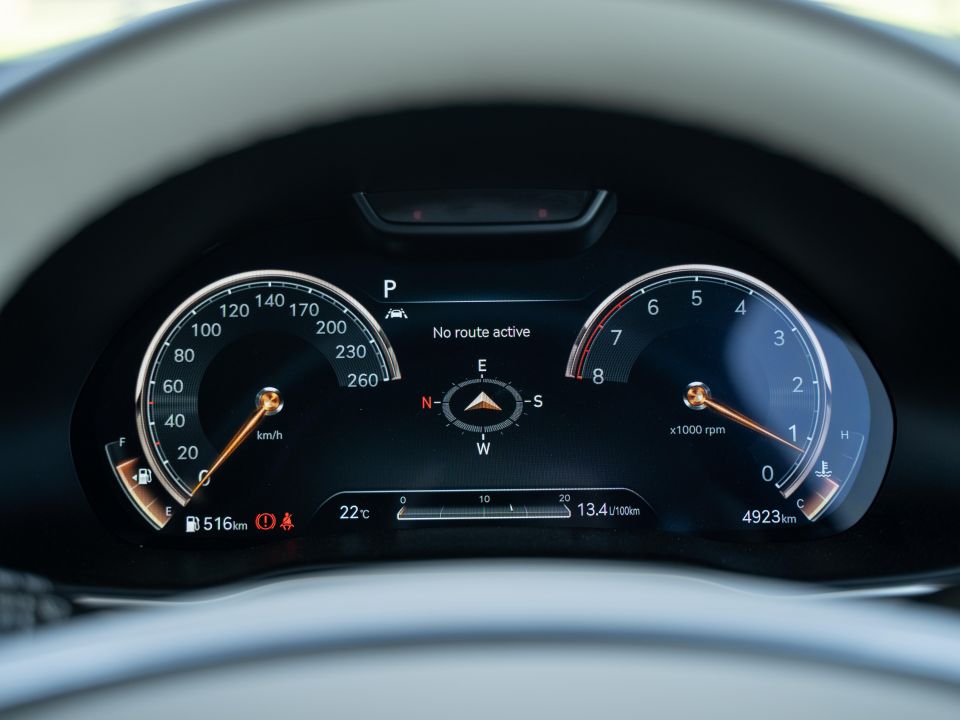

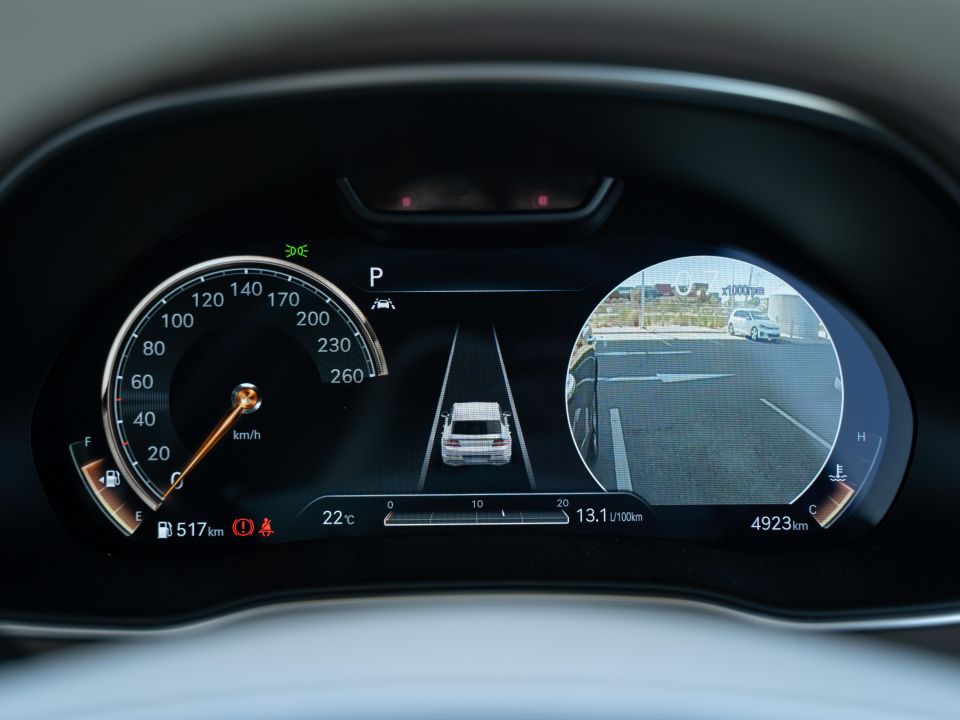
It’s also here where the Genesis projects its Blind Spot View Monitor camera feeds, and unlike non-Luxury Pack models, the video projects into the virtual dial that corresponds with the side of the vehicle you’ve indicated for.
We’ve already said this with other Hyundai/Kia products, but the system here is far more intuitive than the Lane Watch cameras Honda offers. A nice touch.
Storage up front is decent, too. Two adequately-sized cupholders will fit most cups and bottles, and there’s a drawer under the centre stack that doubles up as a wireless phone charger big enough for even my iPhone 12 Pro Max.
Underneath the double centre armrest there’s another decent cubby for other loose items, though the door pockets are a tad skinny for what is likely to be a family vehicle for most buyers.
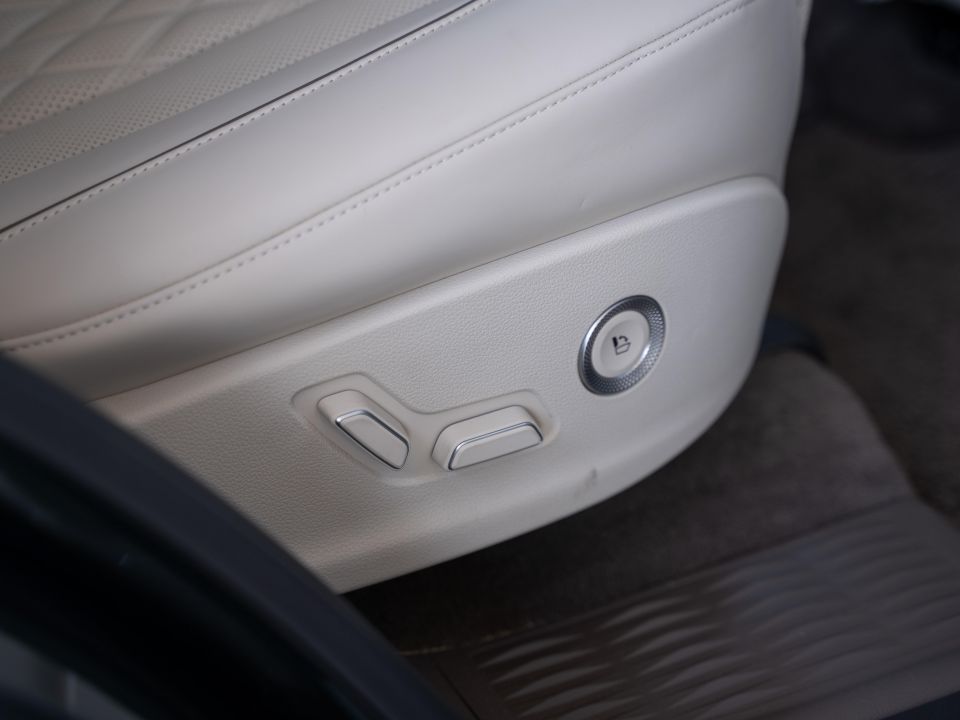


Moving into the second row, the Luxury Pack adds electrically-adjustable outer seats with heating and ventilation, as well as a third zone of automatic climate control. It’s very luxe and all my friends loved the level of adjustment and amenities back there.
Head- and legroom is good even for taller adults like myself (6’1″-ish), and beyond the aforementioned amenities there’s also a fold-down centre armrest with cupholders, as well as shallow door bins and map pockets behind the front seats.
The full-length panoramic glass sunroof (which is fitted as standard unlike on most rivals) is also a nice touch, and the shade is thick enough to handle Australia’s harsh sun.
I managed to cart four friends down to Victoria’s Mornington Peninsula in comfort, so putting kids in the back should be a breeze.
Speaking of kids, the outboard rear seats have ISOFIX child seat mounts and there’s top-tether points across all three positions. If you need to carry more than three in the back, there’s a seven-seat option if you get the all-wheel drive version – though it’s more of a 5+2 layout best left for kiddies.
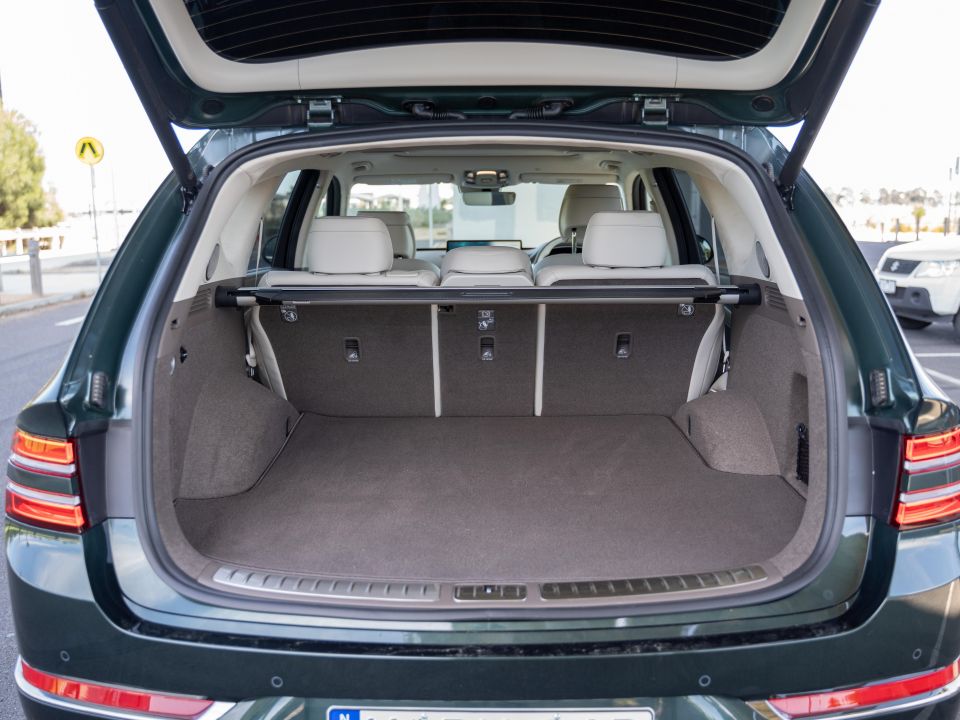
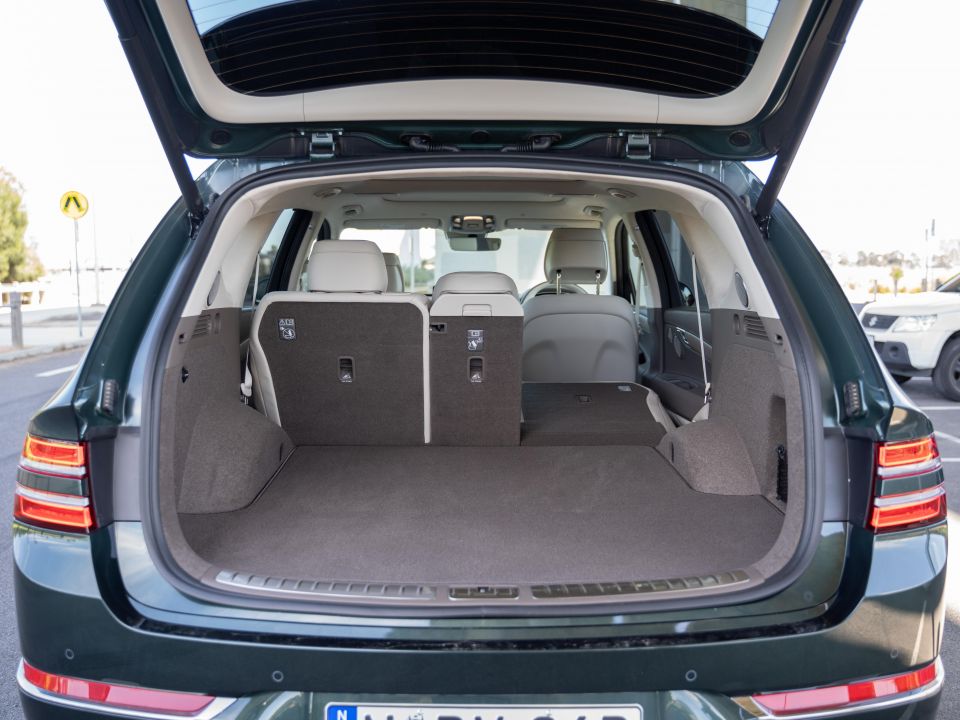
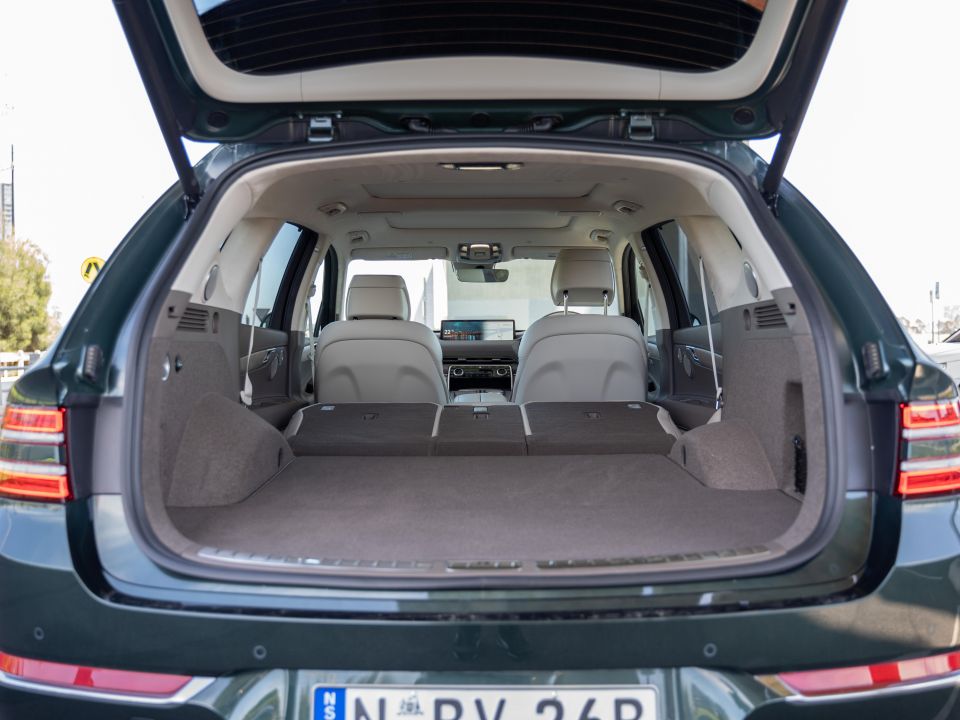


Behind said second row, there’s a 735L boot area more than capable of swallowing the family’s sporting equipment, luggage and prams. Fold the back seats down and there’s 2152L on offer.
Being a five-seat model, there’s a space-saver spare wheel under the boot floor, and there’s also an under-floor storage compartment large enough to fit the cargo cover as well as other loose items.
The Luxury Pack also means the 40:20:40 rear seatbacks can be folded (flat) and raised electronically, and there’s minimal boot lip for easier stowing of heavy items.
It’s certainly more than competitive against its rivals.

Power in 2.5T models comes from the Hyundai Motor Group’s new 2.5-litre turbocharged four-cylinder petrol engine, which develops a healthy 224kW (@5800rpm) and 422Nm (@1650-4000rpm).
In our test car, drive is sent exclusively to the rear axle via an eight-speed automatic transmission. As noted earlier, all-wheel drive is optional.
This same engine will be used in the Hyundai Sonata N Line, and is used in overseas versions of the Hyundai Santa Fe, Kia Sorento and Stinger.
Genesis claims the rear-driven GV80 2.5T RWD will use 9.8L/100km on the combined cycle, with 95 RON premium unleaded required as a minimum for the 80L fuel tank.
Our week with the Genesis returned an indicated readout of 10.4L/100km over 488 kilometres of mixed driving.
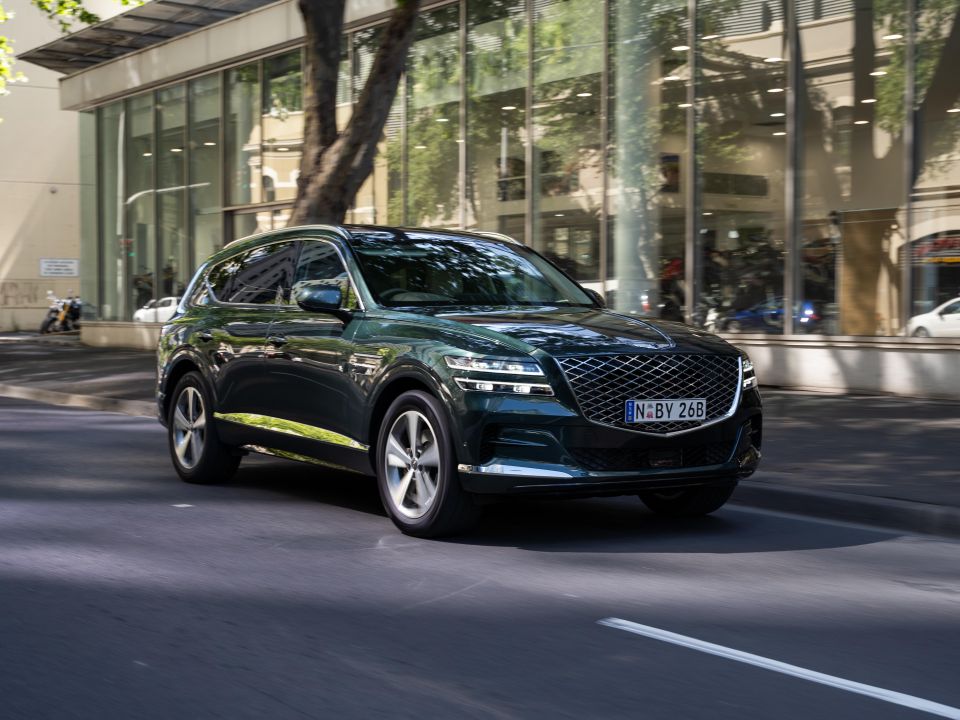
I’ll be honest, I wasn’t expecting much from the GV80’s base powertrain. Usually a four-cylinder large luxury SUV features a diesel that can at least generate enough torque to get moving in a quick enough fashion without being ‘fast’.
On paper, the outputs are pretty decent and are more than a match for the naturally-aspirated V6 petrols of previous generations of product, and 442Nm of torque from just 1650rpm is nothing to sneeze at.
Weighing in at 2073kg (tare), the GV80 2.5T has a surprising amount of pep off the line, and is more than powerful enough to get the big Korean SUV up to Australia’s city and freeway speeds without much fuss.
If you’re concerned about the four-cylinder petrol lacking in aural appeal, there’s a function accessed via the infotainment system to dial up a synthesised sound through the speakers to augment the engine note and make it sound a little more muscular. I had it on one of the middle-range settings so it wasn’t too overbearing or fake-sounding, but anyone in the know will notice it doesn’t sound super authentic.
So, performance is strong from down low and through the mid-range, though you do feel it start to run out of puff between 5000 and 6000rpm. It’s no deal-breaker and most buyers likely aren’t going to push this model like they would the twin-turbo 3.5T AWD.
The eight-speed auto is great, too. It shifts smoothly, intuitively and assertively. It’s up there with the ZF eight-speeders used by Euro marques, and strikes a good balance between performance and economy,
Speaking of economy, it’s disappointing the Hyundai Group brands continue to remove fuel-saving idle stop/start technology from local models. While some prefer to do without this function, the urban fuel savings and lowered emissions would give added piece of mind to those conscious of these aspects of car ownership (like myself), and would be a better match for rival models equipped with this tech – even the Lexus RX300 has it.
Comfort and refinement is yet another plus. On the smaller 20-inch rims and chubbier tyres, the GV80 is cushy and quiet on the move over just about any road surface. Six-cylinder models get adaptive dampers but also fit huge 22-inch wheels and lower profile 265/40 tyres.
The Luxury Pack’s active noise cancellation system no doubt helps by using an array of accelerometers and microphones to monitor road noise entering the cabin and plays opposing sound waves through the speakers.

As noted above the ride has a cushy, floaty feel that does well at ironing out Melbourne’s inner-city lumps and bumps, and that’s with conventional steel springs and fixed dampers compared to the adaptive damping of six-cylinder models and the air-sprung setups of various rivals.
That wafty ride also means the GV80 isn’t super sharp in the bends and can lean a bit, but it’s far from unsettled or wallowy.
The steering has a natural, direct feel to it though is on the lighter side, meaning you have a good idea of what the front wheels are doing without it being a chore to do tight manoeuvres like three-point turns.
You can dial up the weight artificially in Sport mode, but the standard setup has a nice, Euro-luxe feel that makes everyday driving easy and relaxed.
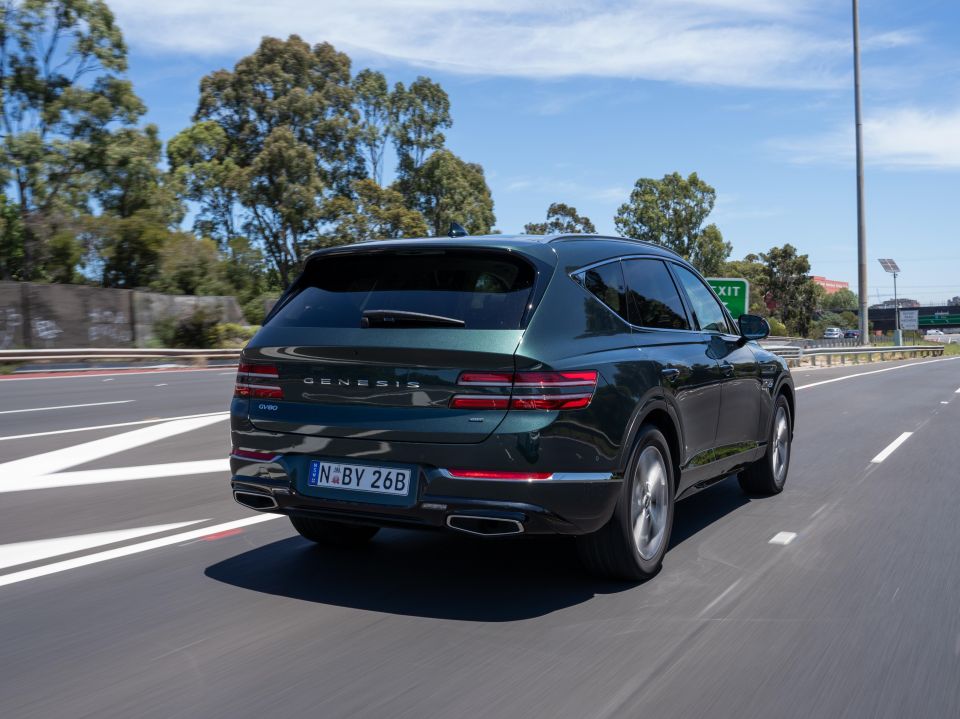
We felt the Genesis is somewhere between the driver-focused BMW X5 and more comfort-focused rivals like the Audi Q7 and Volkswagen Touareg. A happy medium? Maybe.
The extensive time we spent on the open road also meant we had more than enough opportunities to try out all the driver assistance systems on offer.
Adaptive cruise control with stop/go worked well and the GV80 is probably at its best and happiest on the freeway doing 100-110km/h.
The standard lane-keep assist function does the job though could be a little intrusive for some, and we found the lane-centring function (dubbed Lane Follow Assist by Genesis and Hyundai) wasn’t as accurate as we’ve come to expect from Hyundai Group products. I usually leave this system on but it was so inconsistent I just turned it off.

As mentioned earlier, the GV80 comes as standard with the swish Blind Spot View Monitor, which we found quite helpful given the deceptive length of the big rig.
This supplements the standard blind-spot monitoring and rear cross-traffic assist functions, too.
The large head-up display also proved to be quite helpful, being one of the clearer, more contented units of its type.
Likewise the Matrix LED headlights – the matrix function included as part of the Luxury Pack upgrade – were also excellent and the adaptive high-beam function worked very well. Certainly up there with the front lighting I’ve experienced with both the Audi Q7 and VW Touareg.
You’ve probably gathered, I enjoyed driving this thing quite a lot.
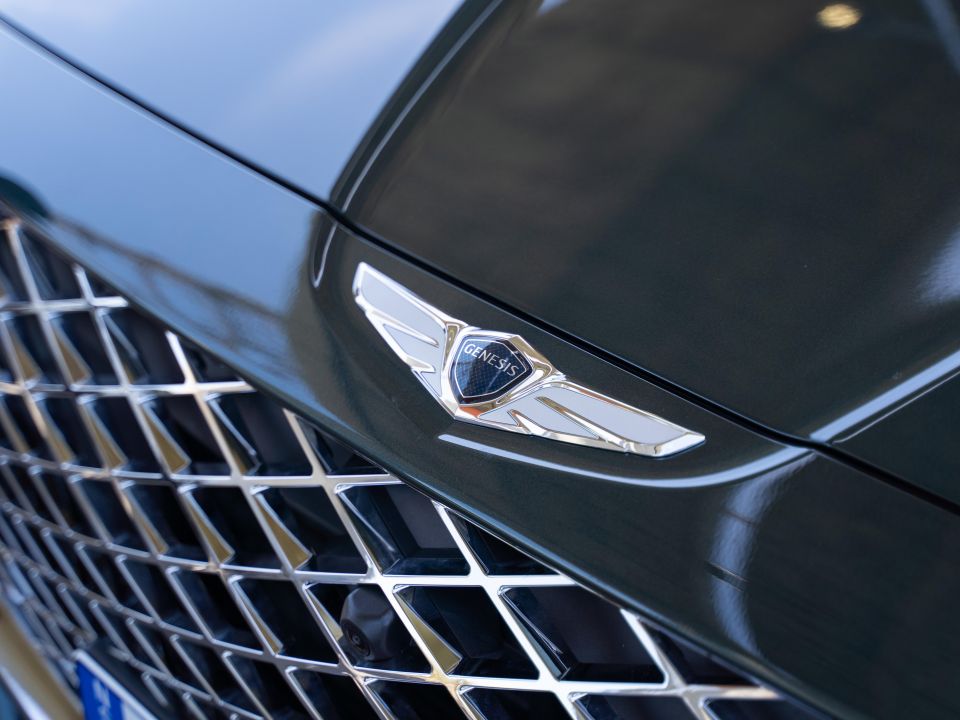
What Genesis lacks in brand recognition and badge cred, it makes up for with a compelling ownership program.
All models come with a five-year, unlimited-kilometre warranty with five years of premium roadside assistance thrown in, too.
Scheduled servicing is also free for the first five years/50,000 kilometres (2.5T requires maintenance every 12 months/10,000km).
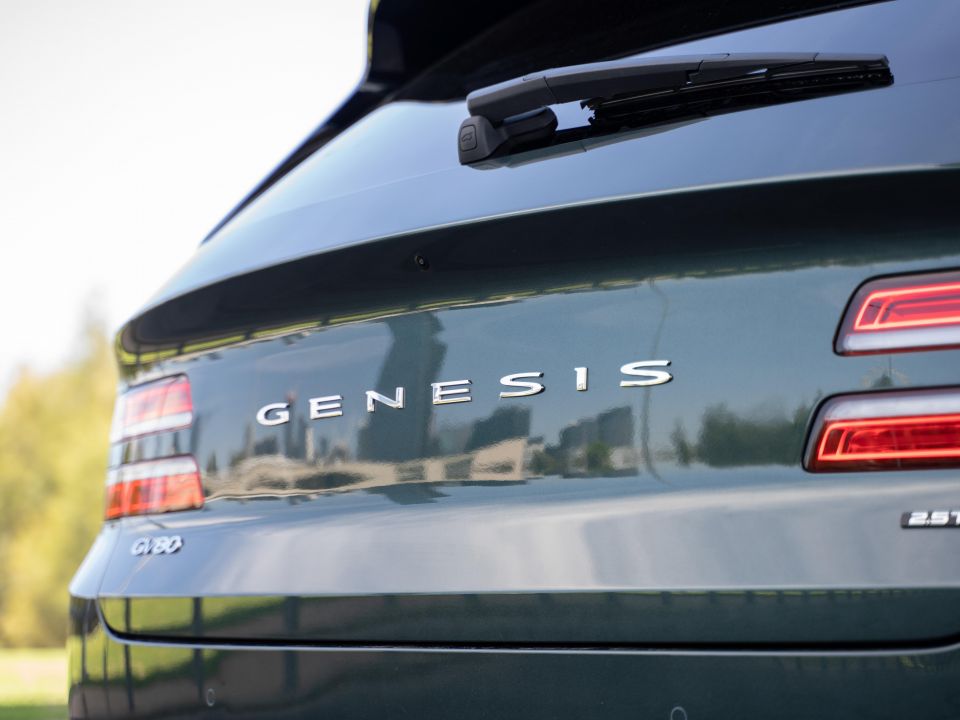
Initially, Hyundai service centres will be staffed with trained Genesis ‘master technicians’, but separate Genesis-branded service centres are said to be in the works.
Genesis Australia is also rolling out a valet program – if you live or work within 70km of a Genesis Studio or test centre, the company will send someone to pick up your vehicle for servicing, and leave you with a courtesy vehicle for the day.
The brand plans to offer these valet services centres in each state as its customer base grows.

Few cars, let alone SUVs, have won my heart like the Genesis GV80.
I wasn’t expecting to enjoy the rear-drive four-cylinder petrol variant as much as I did, the design and colour combination is a winner alone, and the attention to detail in the cabin is refreshing in a time where the established marques are prioritising fancy screens and technology over quality and tactility.
With that said, as a new upstart challenger brand, Genesis’ pricing strategy isn’t compelling enough in this reviewer’s opinion.

If the contents of the Luxury Pack were standard, then maybe, but it’s going to be hard to convince the usual Australian luxury car buyer to walk into a Genesis showroom when A) they don’t actually have any showrooms bar the one Sydney outlet and test drive centre and B) those not in the know will just pass it off as an expensive Hyundai.
Should you choose to take a punt on one of these, though, don’t think you’re ‘settling’. The GV80 is a great car and an excellent first attempt at a luxury SUV from the Korean upstart.
The 2.5T AWD with Luxury Pack is probably the best-value option given the all-paw traction and third row of seats, though the sweet spot in terms of performance and economy would probably be the 3.0D AWD diesel with its muscular oiler.
Anyway, I wish I didn’t have to give this thing back.

Click the images for the full gallery by Wesley Loh (@garagetribe on Instagram)
MORE: Genesis GV80 3.0D v Volkswagen Touareg 210TDI R-Line MORE: Genesis GV80 news and reviews MORE: Everything Genesis
Take advantage of Australia's BIGGEST new car website to find a great deal on a Genesis GV80.
James is an automotive journalist based in Melbourne, Australia. Before joining CarExpert.com.au in 2020, James has worked at leading auto media outlets including Carsales and CarAdvice, as well as at Pulse agency for Ford Australia's communications team. In 2019 James made Mumbrella's 'Top 20 most prolific web authors in Australia' list after publishing 1,360 articles between March 1, 2018 and February 28, 2019 for CarAdvice. James is also an Ambassador for Drive Against Depression – an Australian charity whose mission is to support mental wellness through the freedom of driving and a shared love of cars.


James Wong
3 Days Ago
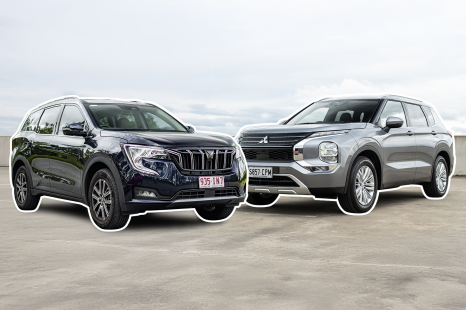

Andrew Maclean
2 Days Ago


Max Davies
2 Days Ago


Max Davies
2 Days Ago


Josh Nevett
1 Day Ago
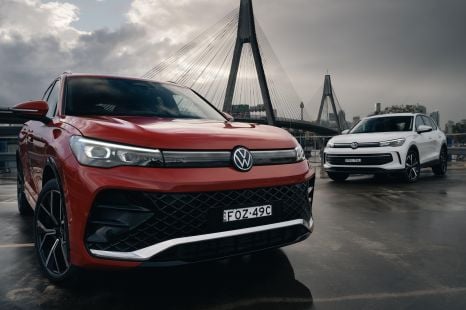

Max Davies
23 Hours Ago